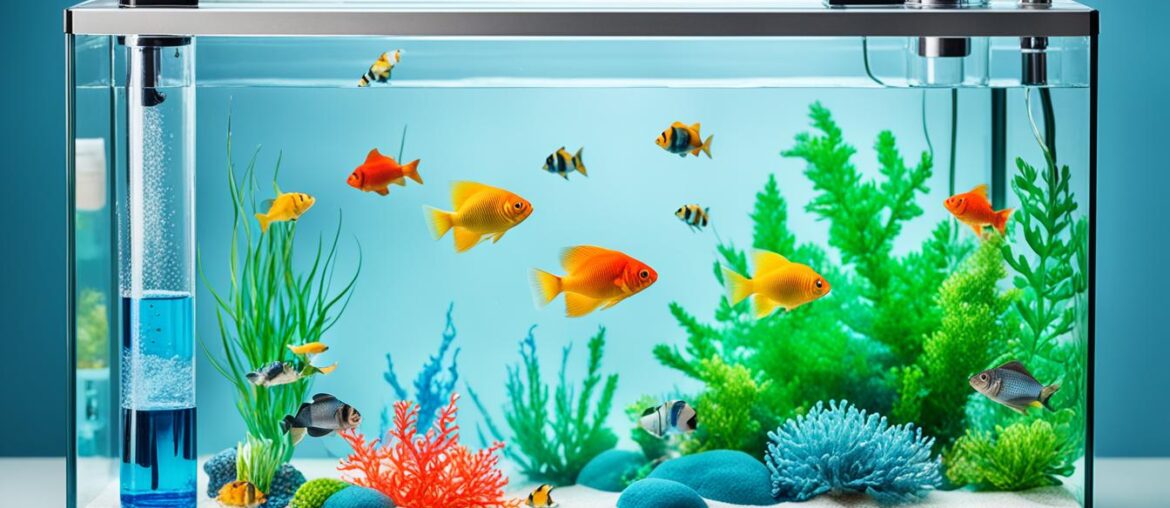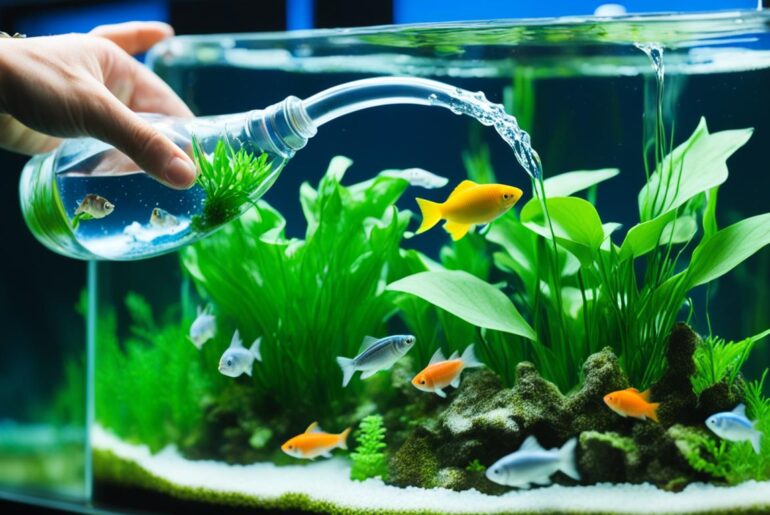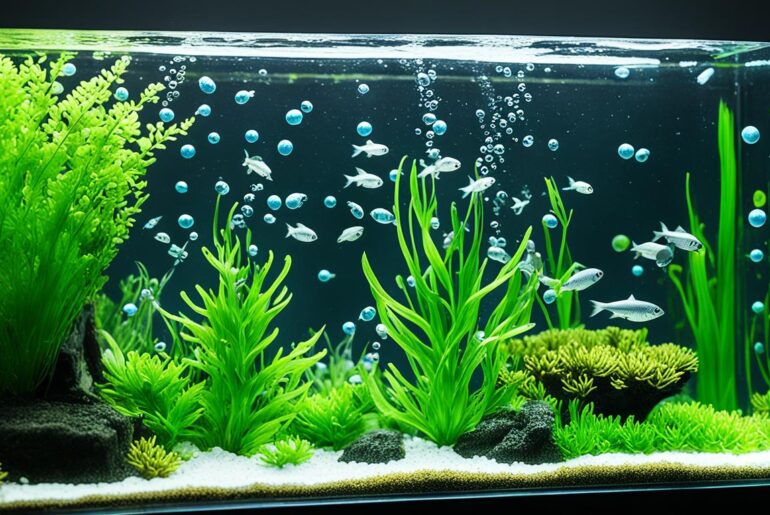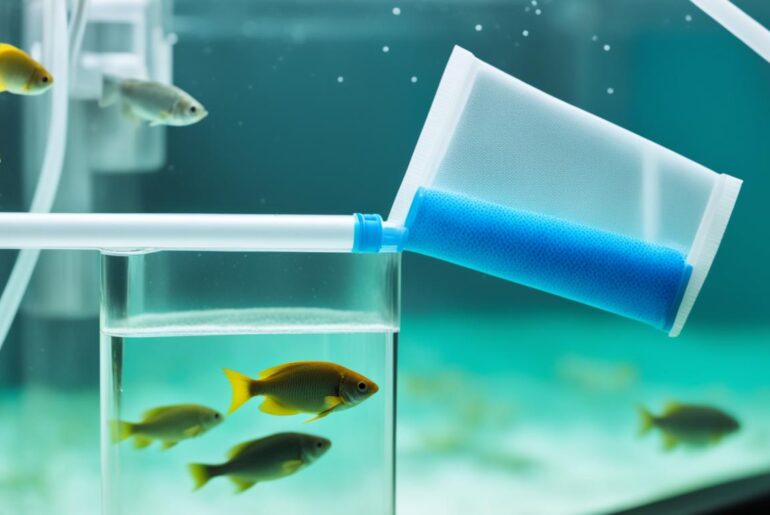As an aquarium enthusiast, I know firsthand the joy and satisfaction that comes from creating a beautiful underwater world for our aquatic friends. Watching the graceful movements of colorful fish and the gentle sway of vibrant plants can be incredibly captivating.
But it’s not all about aesthetics. Creating a healthy environment for our fish and plants goes beyond just visual appeal. It’s about ensuring their well-being and longevity. And one of the most important factors in maintaining a thriving aquarium is testing the water parameters.
Testing the water parameters in your cycling aquarium is like taking a health check-up for your aquatic ecosystem. It allows you to monitor essential elements such as ammonia levels, nitrite levels, pH balance, and more. By regularly testing these parameters, you can detect any issues early on and take action to rectify them.
Imagine this: You diligently observe your aquarium every day, admiring the lively fish and lush vegetation. But suddenly, one day, you notice that your fish are lethargic, their colors are dull, and some may even have developed health problems. It’s a devastating sight for any aquarium owner.
Well, I’ve been there. A few years ago, I faced a similar situation with my prized community of fish. It was heartbreaking to witness their decline, and I couldn’t understand what went wrong. That’s when I realized the importance of testing the water parameters in my aquarium.
Key Takeaways:
- Testing water parameters in your cycling aquarium is essential for maintaining the health and well-being of your fish and plants.
- Regular testing helps you detect any issues early on and take corrective measures to prevent further harm.
- Don’t wait for signs of distress in your aquatic pets. Start testing the water parameters regularly to prevent potential problems.
- My personal experience taught me that neglecting water parameter testing can have devastating effects on your aquarium ecosystem.
- Stay proactive and make testing a part of your regular aquarium maintenance routine.
Why is Testing Water Parameters Important for Your Cycling Aquarium?
Testing the water parameters in your cycling aquarium is crucial for several reasons. Firstly, it allows you to determine the suitability of the water for specific fish and plant species. Different fish and plants require different water conditions to thrive, so by testing the parameters, you can ensure that you are providing the ideal environment for your aquatic pets. Additionally, testing the water parameters helps you identify any issues or imbalances in the water chemistry, such as high levels of ammonia or nitrite, which can be harmful to fish. By regularly testing and monitoring the water parameters, you can take corrective measures to maintain a healthy and balanced aquarium environment.
To further emphasize the importance of water parameter testing, let’s consider a few key reasons:
- Understanding Water Suitability for Fish and Plants: Testing water parameters provides valuable insights into whether the water conditions in your aquarium are conducive to the specific species you keep. Each fish or plant has different water quality requirements, including pH, temperature, and nutrient levels. By testing and adjusting these parameters, you can create an environment that supports the health and well-being of your aquatic inhabitants.
- Prevention of Harmful Conditions: Regular water testing allows you to identify any dangerous conditions, such as high levels of ammonia or nitrite, which can be harmful or even fatal to your fish. By detecting these imbalances early on, you can take immediate action to correct them and prevent potential health issues.
- Monitoring Water Quality: Even if your aquarium seems visually fine, there can still be underlying issues with water quality. Testing the water parameters helps you assess the overall health of your aquarium and maintain a thriving ecosystem. Through routine testing, you can track changes in the water chemistry and detect any trends that require adjustment.
- Promoting Balanced Ecosystem: An aquarium is a delicate ecosystem where multiple factors interact to create a harmonious balance. By regularly testing the water parameters, you can ensure that the essential elements for aquatic life, such as dissolved oxygen levels, pH, and mineral content, are within the optimal range. This promotes the growth of beneficial bacteria, supports plant growth, and prevents the proliferation of harmful substances.
Regular water parameter testing is the foundation of a successful and thriving aquarium. By monitoring and maintaining optimal conditions, you can create a safe and nurturing environment for your aquatic pets.
To better understand the significance of testing water parameters in your cycling aquarium, refer to the following table which highlights some potential consequences of neglecting water quality:
| Issue | Consequence |
|---|---|
| High Ammonia Levels | Ammonia toxicity, fish stress, and potential death |
| High Nitrite Levels | Nitrite poisoning, impaired oxygen transport, and fish fatality |
| High Nitrate Levels | Excessive plant growth, algae blooms, and reduced oxygen levels |
| High pH Levels | Unbalanced acidity, stress on fish, and compromised immune systems |
Note: The consequences mentioned in the table above are not exhaustive and may vary depending on the specific circumstances and species in your aquarium.
Regular testing and monitoring of water parameters in your cycling aquarium is essential for the well-being of your aquatic pets. By maintaining optimal water quality, you can create a thriving and vibrant underwater ecosystem.
Types of Aquarium Water Testing Kits
When it comes to testing the water in your aquarium, there are several types of testing kits available to choose from. Each kit offers its own unique advantages and features, allowing you to accurately monitor the water parameters in your tank. Let’s take a closer look at the different types of aquarium water testing kits:
Liquid Test Kits
One of the most popular options for aquarium water testing is the liquid test kit. These kits, such as the API Master Test Kit, are known for their accuracy and reliability. They typically include individual bottles of reagents for testing various parameters, such as pH, ammonia, nitrite, and nitrate. By following the instructions and adding a few drops of the testing solution to a water sample, you can obtain precise results for each parameter.
Test Strips
Test strips are another commonly used option for testing the water parameters in your aquarium. These strips are convenient and easy to use, making them a popular choice for many aquarium owners. All you need to do is dip the strip into the water and wait for it to change color. The different color changes on the testing pads indicate the levels of various parameters, such as pH, ammonia, nitrite, and nitrate. However, it’s important to note that test strips may not always provide as accurate results as liquid test kits.
Testing Meters
If you’re looking for precise measurements, testing meters can be a great option. These meters are specifically designed to measure specific parameters, such as pH. By using a testing meter, you can obtain accurate readings and eliminate any guesswork. However, it’s important to keep in mind that testing meters may be limited in their ability to test other parameters, so they may not be suitable for comprehensive water testing.
Local Fish Store Tests
Another option for testing your aquarium water is to visit your local fish store. Many local fish stores offer water testing services, allowing you to bring in a sample of your aquarium water for analysis. This can be especially helpful if you’re uncertain about the accuracy of your home testing methods or if you’re in need of expert advice on water parameter management. The staff at your local fish store can provide you with accurate results and recommendations based on their professional experience.
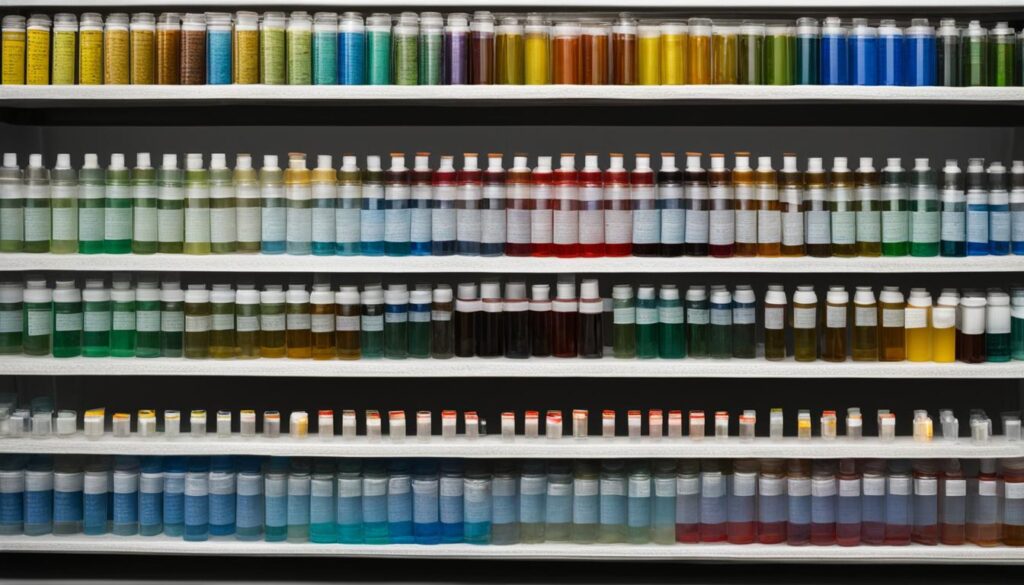
With the variety of aquarium water testing kits available, you can choose the option that best suits your needs and preferences. Whether you opt for a liquid test kit, test strips, testing meters, or local fish store tests, regular monitoring of your water parameters is essential for maintaining a healthy and thriving aquarium environment.
Important Water Parameters to Test in Your Cycling Aquarium
When testing the water parameters in your cycling aquarium, there are several key parameters that you should focus on. These include ammonia, nitrite, nitrate, pH, carbonate hardness (KH), and general hardness (GH).
Ammonia testing is crucial because high levels of ammonia can be toxic to fish. It is important to monitor and maintain low levels of ammonia in your aquarium to ensure the health and well-being of your aquatic pets.
Nitrite testing is equally important as it indicates the progress of the nitrogen cycle in your aquarium. The nitrogen cycle is a biological process that converts toxic ammonia into less harmful substances. By regularly testing the nitrite levels, you can ensure that the cycling process is progressing smoothly and that toxic nitrite levels are kept in check.
Nitrate testing helps to monitor the overall water quality and nutrient levels in your cycling aquarium. Nitrates are the end product of the nitrogen cycle and are relatively less harmful to fish. However, high levels of nitrates can still negatively impact fish health. Regular testing allows you to take necessary actions to control nitrate levels and maintain a balanced aquarium environment.
pH testing measures the acidity or alkalinity of the water in your cycling aquarium. Different fish species have different pH preferences, so it is essential to test and maintain the appropriate pH level for your specific fish population. Fluctuations in pH can stress fish and compromise their immune system, making them more susceptible to diseases.
Carbonate hardness (KH) and general hardness (GH) testing assess the mineral content and stability of the water in your cycling aquarium. These parameters are essential for the well-being of certain species, as they play a role in osmoregulation and overall water chemistry. KH measures the alkalinity of the water, while GH measures the overall mineral concentration. Testing these parameters ensures a suitable habitat for fish and promotes their optimal health.
Regularly testing these important water parameters will help you maintain a healthy and balanced environment for your fish and plants in your cycling aquarium. It allows you to detect any imbalances or issues early on, so you can take appropriate measures to address them and ensure the well-being of your aquatic ecosystem.
| Water Parameter | Importance |
|---|---|
| Ammonia | Toxic to fish; low levels essential for fish health |
| Nitrite | Indicates nitrogen cycle progress; toxic at high levels |
| Nitrate | Monitors water quality; high levels can harm fish |
| pH | Affects fish health and immune system; species-specific preferences |
| Carbonate Hardness (KH) | Affects osmoregulation; stability important for fish |
| General Hardness (GH) | Affects water chemistry; mineral concentration for fish well-being |
Understanding the Difference Between Liquid Tests and Test Strips
When it comes to testing the water in your aquarium, there are two main methods to consider: liquid tests and test strips. Each method has its advantages and limitations, so let’s take a closer look at these two options.
Liquid Tests
Liquid tests involve adding drops of testing solutions to a water sample and observing color changes. These tests are known for their accuracy and reliability, providing more detailed results for each parameter. Liquid test kits, such as the popular API Master Test Kit, often include separate bottles for testing pH, ammonia, nitrite, and nitrate.
Using a liquid test kit allows you to have a more comprehensive understanding of your aquarium’s water quality. The color changes produced by the testing solutions can be matched with a color chart to determine the concentration of each parameter. This method gives you precise measurements and helps you identify any imbalances or issues in your aquarium’s water chemistry.
Test Strips
Test strips, on the other hand, are small paper strips with multiple testing pads. To perform a test using test strips, you simply dip the strip in the water and wait for the testing pads to change color. The color changes can then be compared to a color chart to determine the levels of various parameters.
Test strips are often favored for their convenience and ease of use. They provide quick results, allowing you to assess the water parameters without waiting for a chemical reaction. However, it’s important to note that test strips may not be as precise as liquid tests. The color changes on test strips can be subjective, and the results may not be as accurate as those obtained through liquid tests.
Ultimately, the choice between liquid tests and test strips depends on your needs and preferences. If you prioritize accuracy and detailed results, liquid tests are the way to go. On the other hand, if convenience and quick results are your priority, test strips may be a suitable option for you.
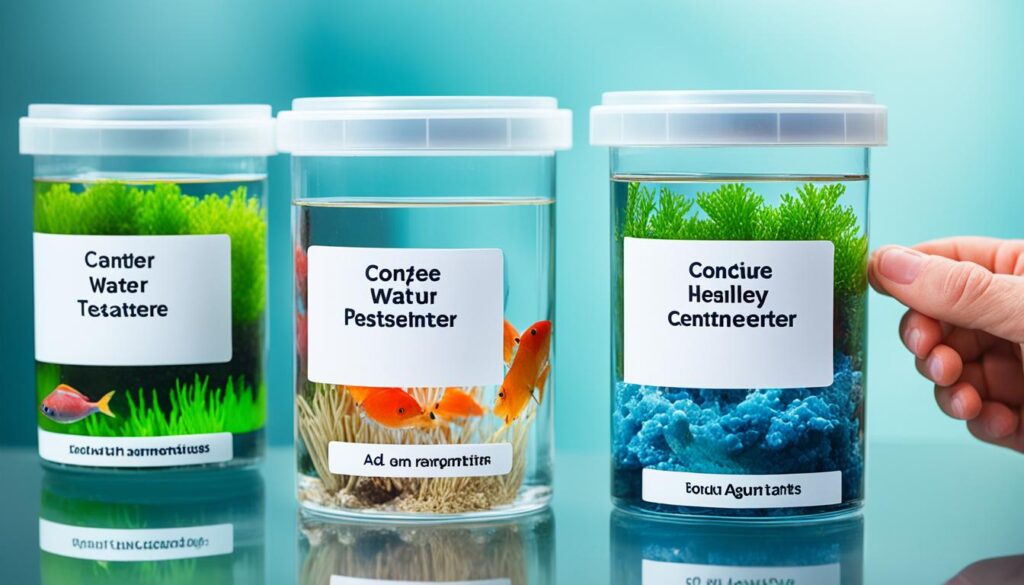
How to Test Water Parameters with Liquid Test Kits
When it comes to testing water parameters in your cycling aquarium, liquid test kits are a reliable and accurate choice. Follow these steps to effectively test the essential parameters: ammonia, nitrite, nitrate, and pH.
- Fill a clean glass test tube with the required amount of aquarium water. Make sure to use a separate tube for each parameter to avoid cross-contamination.
- Add the corresponding number of drops of the testing solution to each test tube, as indicated by the instructions on the kit.
- After adding the drops, securely close the test tube and gently shake it to mix the solution with the water.
- Allow the test tube to sit undisturbed for the specified duration, typically a few minutes, to allow the color change to occur.
- Compare the color of the solution in each test tube to the color chart provided with the test kit.
- Identify the concentration of each parameter by matching the color of the solution to the closest shade on the chart. This will give you the accurate measurement of ammonia, nitrite, nitrate, and pH in your aquarium water.
- Repeat the process for each parameter you wish to test.
Regularly testing your water parameters using liquid test kits is essential for maintaining a healthy and balanced aquatic environment. It allows you to detect any imbalances or potential issues early on and take appropriate measures to rectify them. Ensure that you follow the instructions provided with your chosen test kit for accurate and precise results.
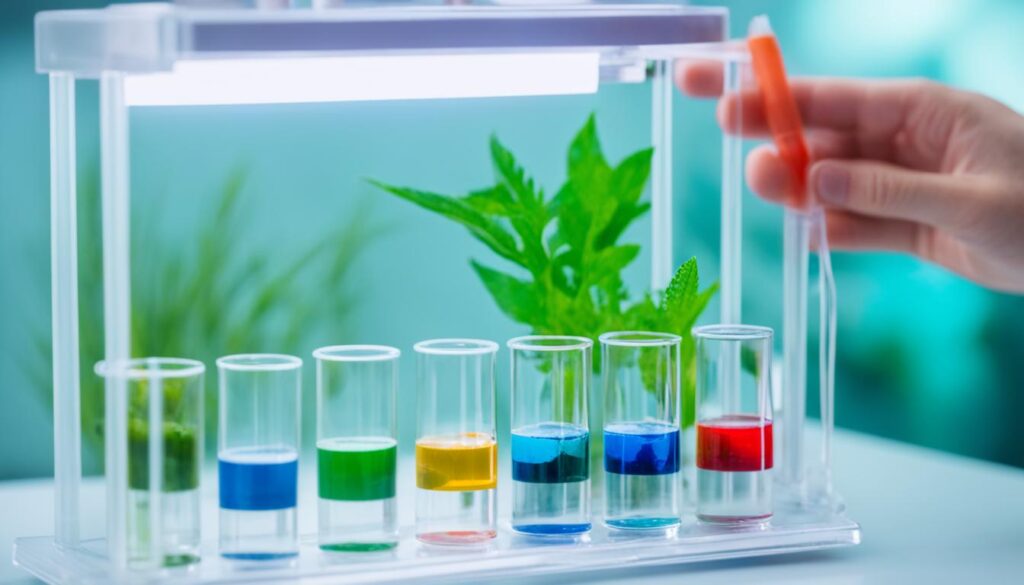
Tips for Accurate Testing:
- Always use clean test tubes and rinse them thoroughly between tests to prevent contamination.
- Follow the instructions on the liquid test kit carefully, as different kits may have slight variations in testing procedures.
- Store your liquid test kit in a cool and dry place to maintain its effectiveness.
- Consider testing your water parameters at the same time each day to establish a consistent testing routine.
- Record your test results in a logbook or spreadsheet to track any changes or trends over time.
By regularly testing your aquarium’s water parameters using liquid test kits, you can ensure a healthy and thriving underwater ecosystem for your fish and plants. Monitoring these parameters will help you maintain optimal water quality, prevent potential issues, and provide the best living conditions for your aquatic pets.
How to Test Water Parameters with Test Strips
Testing water parameters in your aquarium is crucial for maintaining the health and well-being of your aquatic pets. One simple and convenient method of testing is using test strips. Test strips offer aquarium owners an easy way to monitor essential water parameters such as nitrite levels, nitrate levels, and pH balance. Here’s how you can effectively test water parameters with test strips:
- Dip a test strip into the aquarium water for a few seconds.
- Remove the test strip from the water and let it dry.
- The testing pads on the strip will change color to indicate the levels of various parameters, including nitrite, nitrate, and pH.
- Using a color chart provided with the test strips, compare the color changes on the pads to determine the concentration of each parameter.
By regularly using test strips to monitor water parameters, you can quickly assess the quality of your aquarium water. The convenience and ease of use make test strips a popular choice among aquarium owners who want to ensure optimal water conditions for their fish and plants. It is recommended to follow the instructions provided with the test strips and perform tests at regular intervals to maintain a healthy and balanced aquarium environment.
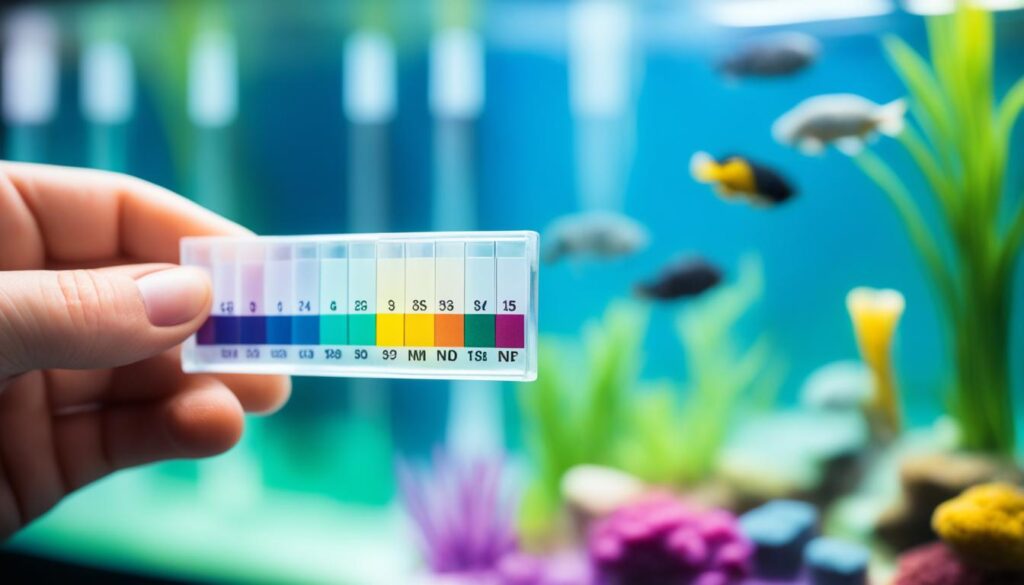
Using test strips to monitor water parameters is a valuable practice for any aquarium owner. These simple tools provide a quick and reliable way to assess the levels of nitrite, nitrate, and pH in your aquarium water. By regularly testing and monitoring these parameters, you can make informed decisions about water treatments, fish compatibility, and overall aquarium health. Take advantage of the convenience and ease of use that test strips offer to ensure a thriving and vibrant aquarium ecosystem.
How to Test Water Parameters at a Local Pet Store
If you prefer not to perform the water parameter tests yourself, you can take a water sample to your local pet store for testing. Most local fish stores offer water testing services and can provide you with accurate results. Simply collect a sample of your aquarium water in a clean container and bring it to the store. The store’s staff will use their own testing equipment to analyze the sample and provide you with the necessary information. This option is especially useful if you are unsure about the accuracy of your home testing methods or if you need expert advice on water parameter management.
Visiting a local pet store for water testing is a convenient and reliable way to ensure that your aquarium’s water is properly balanced. The store’s staff have the knowledge and experience to accurately assess the water parameters and recommend any necessary actions. By relying on their expertise, you can have peace of mind knowing that your fish and plants are living in a healthy environment.
| Advantages of Local Pet Store Water Testing | Disadvantages of Local Pet Store Water Testing |
|---|---|
|
|
When visiting the local pet store for water testing, remember to collect the water sample properly to ensure accurate results. Use a clean container, preferably one that has not been exposed to any chemical substances that could contaminate the sample. Also, it’s important to communicate any specific concerns or issues you have with your aquarium so that the store’s staff can provide tailored assistance.
By utilizing the water testing services offered by your local pet store, you can take proactive steps towards maintaining optimal water parameters in your aquarium. Regular testing and monitoring will help you identify any imbalances and allow you to make the necessary adjustments for a healthy and thriving aquatic environment.
Conclusion
Regular testing of water parameters is crucial for maintaining a healthy and thriving aquarium environment. By understanding the importance of water testing and following the steps outlined in this guide, you can ensure that your cycling aquarium remains in optimal condition.
Remember to choose the appropriate testing method that suits your needs, whether it’s using liquid test kits or convenient test strips. Test the key parameters regularly, such as ammonia, nitrite, nitrate, pH, carbonate hardness, and general hardness, to monitor the water quality and detect any imbalances.
If any issues or imbalances are identified, take corrective measures promptly to create a safe and supportive environment for your fish and plants. By maintaining a diligent approach to water parameter testing, you can provide a healthy aquarium environment and promote the well-being of your aquatic pets.
FAQ
Why is testing water parameters important for your cycling aquarium?
Testing water parameters in your cycling aquarium is important because it helps maintain a healthy aquatic environment for your fish and plants. Regular testing ensures optimal water quality and prevents potential issues that may arise.
What are the types of aquarium water testing kits available?
There are several types of aquarium water testing kits available, including liquid test kits, test strips, testing meters, and local fish store tests. Each has its advantages and considerations.
What are the important water parameters to test in your cycling aquarium?
The important water parameters to test in your cycling aquarium include ammonia, nitrite, nitrate, pH, carbonate hardness (KH), and general hardness (GH). Testing these parameters helps monitor the health and stability of your aquarium.
What is the difference between liquid tests and test strips?
Liquid tests involve adding drops of testing solutions to a water sample and observing color changes, while test strips are dipped in the water and produce color changes that can be compared to a color chart. Liquid tests tend to be more accurate and provide more detailed results, while test strips offer convenience and quick results.
How do you test water parameters with liquid test kits?
To test water parameters with liquid test kits, you fill a test tube with a specific amount of aquarium water, add drops of testing solutions, shake the tube, and wait for a color change. The color is then compared to a chart to determine the concentration of the tested parameter.
How do you test water parameters with test strips?
To test water parameters with test strips, you dip a strip into the aquarium water for a few seconds, remove it to let it dry, and compare the color changes on the strip to a color chart. The color changes indicate the concentration of each parameter.
How can you test water parameters at a local pet store?
To test water parameters at a local pet store, you collect a sample of your aquarium water in a clean container and bring it to the store. The staff will use their own testing equipment to analyze the sample and provide you with accurate results.
